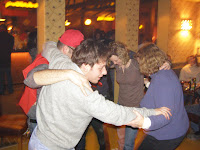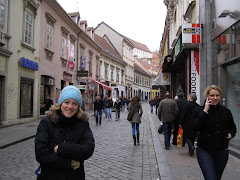Feb 14th, 2008

Kyle's former high school teacher, Janet Tower who had been teaching at the American School of Kosovo for nearly two years invited us to visit her in the capital of Prishtina, and since we were in the Balkans area, we took a night bus headed straight from Sarajevo, through Serbia into the UNMIK (the UN mission in Kosovo) border between Kosovo and Serbia, and f inally to Prishtina. As a consequence, we were there "accidentally" for the independence declaration of, what ethnic Kosovo Albanians call the "Great Republic of Kosova" (see the pic on the right of man preparing to celebrate with an Albanian flag). Upon arrival to Kosovo, we encountered not one soul that spoke English at the bus station who could tell us how to get downtown. We headed in the direction that best suited our hunch. As we left the bus station behind, we’d bump into banners praising former presidents Clinton! A few blocks down there was a “Europecar” rental with a sign in English…and it was the hunch again that told us maybe the folks obliged to deal with tourists daily would speak a word or two of English and point us in the right direction. The man was so nice we were almost considering renting a car from him for 25 euros a day... He told us to ask for “Mother Theresa street” and off we went. To our surprise the bus driver spoke very good English and told us exactly where to get off. Buildings were certainly run down but on the inside they were flush - perfectly clean and inviting…and modern! We sat down at a café to use the bathroom more than anything and were surprised that a big “kaffa sa mljeko” (as it would be in Croatian or Bosnian – means coffee with milk) and a tea would cost a single euro. It is definitely not the tag price for even a regular espresso at the fancy “brasseries” in Paris. We headed
inally to Prishtina. As a consequence, we were there "accidentally" for the independence declaration of, what ethnic Kosovo Albanians call the "Great Republic of Kosova" (see the pic on the right of man preparing to celebrate with an Albanian flag). Upon arrival to Kosovo, we encountered not one soul that spoke English at the bus station who could tell us how to get downtown. We headed in the direction that best suited our hunch. As we left the bus station behind, we’d bump into banners praising former presidents Clinton! A few blocks down there was a “Europecar” rental with a sign in English…and it was the hunch again that told us maybe the folks obliged to deal with tourists daily would speak a word or two of English and point us in the right direction. The man was so nice we were almost considering renting a car from him for 25 euros a day... He told us to ask for “Mother Theresa street” and off we went. To our surprise the bus driver spoke very good English and told us exactly where to get off. Buildings were certainly run down but on the inside they were flush - perfectly clean and inviting…and modern! We sat down at a café to use the bathroom more than anything and were surprised that a big “kaffa sa mljeko” (as it would be in Croatian or Bosnian – means coffee with milk) and a tea would cost a single euro. It is definitely not the tag price for even a regular espresso at the fancy “brasseries” in Paris. We headed  to the American School of Kosovo (pic on the right) where Janet Tower, Kyle’s former high school English teacher was now working at. As we headed to the school, I have to admit that I was surprised we were actually standing in the city center for there were absolutely no historical buildings in sight, no important churches or mosques or pretty streets, just filthy dirty roads, garbage wrappers and you name it dumped everywhere in a bustling metropolis with people selling one-euro cigarette packs on every other corner (With cigarettes this cheap, it is to no wonder why every single Kosovar smokes, plus there are no smoking bans in bars or restaurants... or anywhere in the Balkans actually…my lungs were able to breathe again only until we reached France…ironically enough). Sadly, the city seemed filthier than the most neglected and polluted streets of Mexico city. But it being dirty and there being no historical monuments in
to the American School of Kosovo (pic on the right) where Janet Tower, Kyle’s former high school English teacher was now working at. As we headed to the school, I have to admit that I was surprised we were actually standing in the city center for there were absolutely no historical buildings in sight, no important churches or mosques or pretty streets, just filthy dirty roads, garbage wrappers and you name it dumped everywhere in a bustling metropolis with people selling one-euro cigarette packs on every other corner (With cigarettes this cheap, it is to no wonder why every single Kosovar smokes, plus there are no smoking bans in bars or restaurants... or anywhere in the Balkans actually…my lungs were able to breathe again only until we reached France…ironically enough). Sadly, the city seemed filthier than the most neglected and polluted streets of Mexico city. But it being dirty and there being no historical monuments in sight all had its explanation – we learned later on that Prishtina was not always the capital of Kosovo’s region. In 1918 when Kosovo ceased to be a part of Albania and instead became part of the Republic of Serbia, Kosovo along with the small city of Prishtina was just a province of the greater Republic of Yugoslavia. Only until 1946, under Tito’s rule, did Prishtina become the capital of the Socialist Autonomous Region of Kosovo, when Tito allowed the region to stand for itself. As for the garbage, it seems that after communism fell, nobody was in charge of picking it up, so no one volunteered to do it, plus they have to landfills in the country...so they could gather it, but then where would they dump it? They're still trying to figure this one out.
sight all had its explanation – we learned later on that Prishtina was not always the capital of Kosovo’s region. In 1918 when Kosovo ceased to be a part of Albania and instead became part of the Republic of Serbia, Kosovo along with the small city of Prishtina was just a province of the greater Republic of Yugoslavia. Only until 1946, under Tito’s rule, did Prishtina become the capital of the Socialist Autonomous Region of Kosovo, when Tito allowed the region to stand for itself. As for the garbage, it seems that after communism fell, nobody was in charge of picking it up, so no one volunteered to do it, plus they have to landfills in the country...so they could gather it, but then where would they dump it? They're still trying to figure this one out.
Prishtina might not have been the "prettiest" tourist attraction, but for us it was more the history and culture contained therein that made it attractive and as the Serbian’s now claim, Kosovo is the cradle of a civilization. A lot of Yugoslavian history, suffering and war lessons are contained in this province. Ironically, this is one of its charms... not to mention the beauty of the Albanian culture and the people we encountered!
Kosovo Albanian Students
We got to meet the students of the American School of Kosovo (ASK) and from the very beginning we were amazed by the student’s apparent interest not only in international politics and identity, but in their own culture and in the betterment of their society. Ereblir Kadriu, a Kosovo Albanian guidance counselor who has facilitated TOELF and SAT test-taking at the ASK, initiated a Social Issues conference for his students. Basically, the students research, go out to libraries, conduct interviews, create graphs, and obtain information from governmental institutions about social issues enveloping them. They write up their research and findings and present it at a regional conference (this year international inviting different Balkan countries including Serbia).
The difference between these high school students and the ones I’ve encountered here in France, the US and even Guiana are interesting and almost a matter of concern. The former ones just seemed a lot more interested in the world, the international scene and overall politics of the world. In our western society, most students aren’t influenced by social issues in such a direct way, nor do they show so much interest and involvement until the later stages of their lives when they reach college perhaps. These high school kids in Kosovo seemed ready to change the world and could hold their own in political debates about the US candidates and US culture clashes with the East with your average college student. I was blown away. I must mention that these students all spoke fluent English. Why such a vast difference between Kosovo students and the ones in private schools in the US, Mexico, or France? Maybe it has a lot to do with being part of or a victim of war.


In pictures
1.Janet, Kyle and I at a Pizzeria in Prishtina
2. In text - Man decorating his car for Independence with the Albanian flag
3. In text: Me in front of the American School of Kosovo during the independence celebration in Prishtina
4. In text - Banner of former Kosovo President Rugova, who would end his speeches with: "God bless Kosova, god bless the people of Kosova and god bless the friends of Kosova"
5. Albanian and American flags hanging side by side all over Prishtina
6. Banner of adored President Clinton above the boulevard named in his honor. Former Secretary of State, Madeleine Albright is very much loved here as well.

































